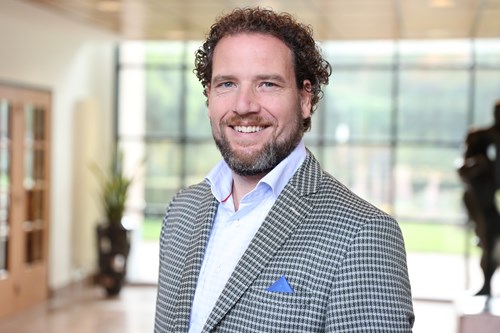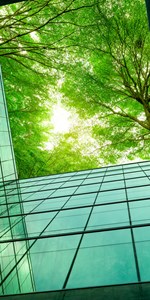Just before the summer, the Association drew up a manifesto . Together with Schoonmakend Nederland and NIVRE, the Association wants sustainable damage repair to be commonplace by the end of 2024. How far along are insurers? What can they do? In a series on sustainable damage repair, various insurers have their say. In this fourth part the story of Donatus.
It's busy at the office in Rosmalen. Immediately after entering, the logo of the church insurer on the doormat stands out. In the waiting room there is all kinds of appropriate reading material, including the magazine Klooster! The neatly displayed magazines immediately make it clear that Donatus does much more than just insure churches. "We insure all kinds of monumental buildings for reconstruction value. These can be churches, but also a castle or a farm," says appraiser Derk-Jan Baarda.
 Monument insurer Donatus
Monument insurer Donatus
More than eighty percent of the few thousand churches in the Netherlands are insured with Donatus. Unlike, for example, in Belgium and France where the church is owned by a municipality or the state, in our country churches themselves are responsible for whether or not the building and the inventory are insured. The majority therefore take out insurance, which is based on reconstruction value.
The biggest risk for a church or other monumental building is fire. Really large fires, with damage above one million euros, occur on average about once or twice a year. The main cause is human activity, which includes fire-hazardous restoration work, but also vandalism.
Thorough inspection
Baarda calls it "important and good" that the Sustainable Damage Repair Manifesto is available. "We are still looking at all kinds of installations in churches and monuments, especially with a view to fire, but we are happy to think along with you about how we can preserve cultural heritage and save the climate."
For example, when a new member joins the mutual agreement, a thorough inspection always takes place before the policy is finalised. Baarda: "Let me start by saying that the monuments that are still there today were often built in a fairly sustainable way. This is mainly due to the method of construction and the use of sustainable materials, such as bricks and wood. You really can't compare the pine beams of today with those of the past. The wood from back then is much more sustainable than the wood we use now."
Heat pump
In daily practice, Baarda regularly sees monumental farms in particular undergo a true metamorphosis. "When new residents come to us, the farm is often exactly as it was sixty years ago. With a box bed, a fireplace, carpet and a thatched roof. New owners want to turn it into a contemporary home. The thick outer walls will remain in place and on the inside there will be secondary walls with insulation material. They take just about every sustainable measure there is, including a heat pump. We always call that new construction with an old shell."
He adds that Donatus does not demand that sustainability from its members. "We don't think that's up to us either. After all, not much changes from a risk point of view. Whether someone heats their home with a heat pump or central heating system doesn't make much difference to the risk of fire."
 Derk-Jan Baarda
Derk-Jan Baarda
Know-how meeting
On the other hand, Baarda sets the bar high. "If you're going to be more sustainable, do it right." That is why he is a member of the Technical Committee of the Association, together with other members. "We produce prevention brochures, in which we give tips for the safe use of solar panels, among other things. Together, we can ensure greater safety and knowledge sharing."
And that is exactly what he strives for in his position as Team Leader Appraisals and Expertise at Donatus: sharing knowledge. He has ten appraisers/loss adjusters in his team and organises a 'know-how' meeting about two to three times a year. "We then meet with one of our members on location and, for example, go to a church that has just insulated the roof or restored the organ. We would like to collect the knowledge of the market and share it with the rest of the market. Our members regularly ask us how they can best become more sustainable."
"Together, we can ensure more safety and knowledge sharing"
Building Decree
Monumental buildings cannot simply take all energy-saving measures to become more sustainable, but Baarda emphasises that many owners are willing to do so. "What's more, in the event of damage, a municipality is increasingly saying: if the roof is removed now, you can immediately meet the current requirements and insulate that roof in accordance with the Building Decree."
Sustainable insulation, for example after a fire, is almost always more expensive than if it had to be installed in a new building, but these additional costs (renamed by Donatus as: costs ordered by the government) are insured up to 100,000 euros 'free of charge'.
Hydrogen
Large buildings are also major users of energy and, according to Baarda, churches are therefore eagerly looking for sustainable alternatives. "A church in Limmen, for example, used sheep's wool as an 'alternative' insulation material. In addition, if the roof is damaged, the floor is often immediately tackled and underfloor heating is installed. And finally, many churches are looking at how they will be able to heat the building when the neighbourhood in which they are located is going to be off the gas."
Some are already seeking refuge in electricity or heating the church with infrared panels. Baarda even knows of a church in Arnhem that is investigating whether the building can be heated with hydrogen.
"A church in Arnhem is investigating whether the building can be heated with hydrogen"
Underfloor heating in the church
Baarda does not know exactly how many churches are already equipped with underfloor heating, but he estimates that this is the case for "at least half". "Initially, many churches installed underfloor heating to keep more people in the church. After all, it's a lot more comfortable with than without. But at the moment, underfloor heating is increasingly being installed in the context of sustainability."
He gives the example of the Eusebius Church in Arnhem, which had the old floor tiles (tombstones) carefully removed during a restoration. "After that, underfloor heating was installed and the old tiles were put back in place."
Solar panels
He comes back to it a few times in the conversation: "if we want to keep what we have, we have to move with the times". And of course, not every monumental building lends itself to modern gadgets such as solar panels, but here too the members of Donatus appear to be practical in nature. "In monumental churches, installations are sometimes placed between two roof surfaces. So the solar panels are there, but you can't see them. Finally, I know of an example of a modern church that had the solar panels placed on the roof in the shape of a cross. So a lot is possible," Baarda concludes, "as long as you think about it carefully."
Was this article useful?


